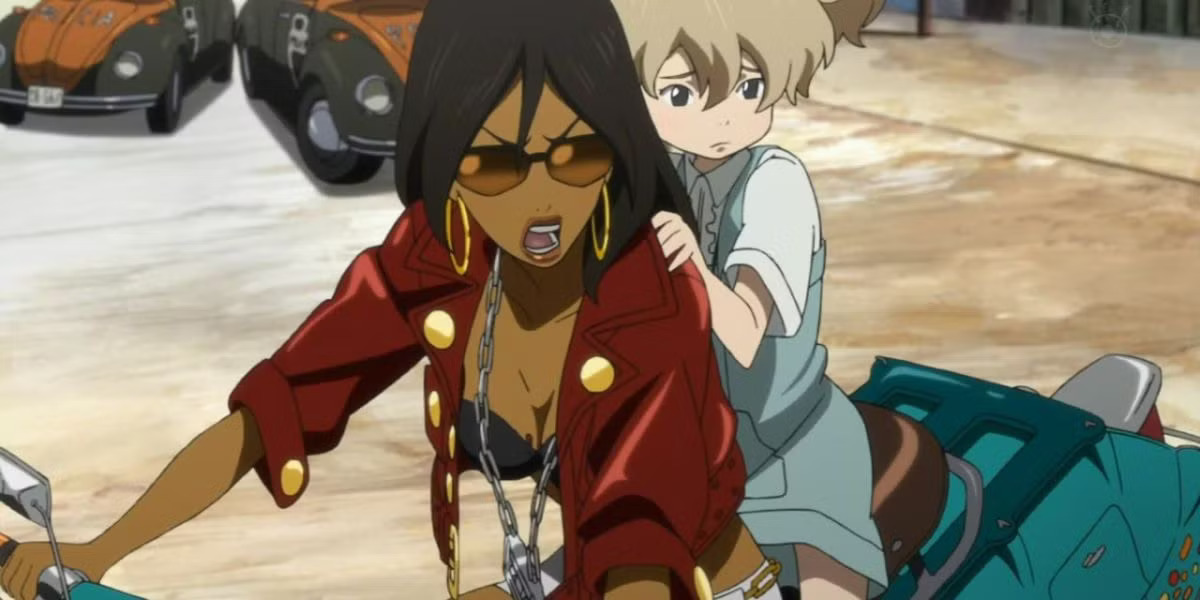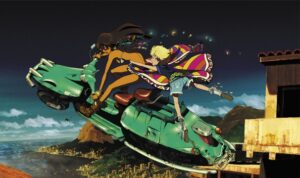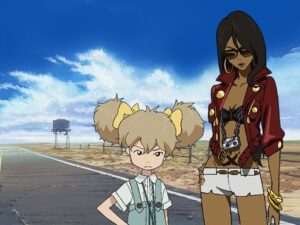Retrospective: “Michiko and Hatchin” 10th Anniversary Toonami Retrospective

 Michiko and Hatchin was a very significant piece of anime and Toonami history, but primarily for signifying the end of an era rather than the beginning of one. Adult Swim Action was initially created to be the place for adult action animation, although in actuality, the teen oriented shonen titles like Inuyasha and Bleach became massively merchandised pop culture sensations while most of the actual adult titles tended to be ratings flops. Despite being called Adult Swim Action, the block was infamous for dialogue heavy drama titles that had a fanatically devoted cult audience, yet were rejected by the mainstream crowds and got low Neilson ratings. This culminated in Adult Swim Action rebranding itself to the name of Cartoon Network’s Toonami block, a block mainly known for action anime. Jason Demarco took over as showrunner of the new block from Kim Manning and phased out the drama heavy titles. That is of course, with the exception of the subject of this retrospective, the classic Michiko and Hatchin, which premiered on Toonami June 20, 2015.
Michiko and Hatchin was a very significant piece of anime and Toonami history, but primarily for signifying the end of an era rather than the beginning of one. Adult Swim Action was initially created to be the place for adult action animation, although in actuality, the teen oriented shonen titles like Inuyasha and Bleach became massively merchandised pop culture sensations while most of the actual adult titles tended to be ratings flops. Despite being called Adult Swim Action, the block was infamous for dialogue heavy drama titles that had a fanatically devoted cult audience, yet were rejected by the mainstream crowds and got low Neilson ratings. This culminated in Adult Swim Action rebranding itself to the name of Cartoon Network’s Toonami block, a block mainly known for action anime. Jason Demarco took over as showrunner of the new block from Kim Manning and phased out the drama heavy titles. That is of course, with the exception of the subject of this retrospective, the classic Michiko and Hatchin, which premiered on Toonami June 20, 2015.
This title was very much a throwback to the type of shows that aired when Kim Manning was showrunner of Adult Swim’s anime block, being a very grounded dialogue heavy drama title. This title took a while to make it to the spotlight, originally flopping hard in its native Japan in 2008 and not getting a US release until Funimation gave it a modestly successful DVD release in 2013. In 2015, Michiko and Hatchin got to air during the peak of Toonami’s Renaissance, airing alongside megahits Dragon Ball Z Kai and Kill La Kill and able to get over one million viewers during its 1:00 AM Eastern timeslot. The series was directed by Sayo Yamamoto, who intended the series for an audience of adult women, a quite different audience than the mainly teenage boy titles aired on Toonami. Studio Manglobe, the now defunct studio responsible for legendary hits like Samurai Champloo, was behind the series. Shinichiro Watanabe, the director of Cowboy Bebop and Samurai Champloo, directed the music.
The show’s plot involves a little girl named Hana “Hatchin” Morenos (voiced in the English dub by Jad Saxton), who is raised by a foster family who treats her like garbage. One day, a tough and sexy lady on a motor scooter breaks in and takes her away from said foster family. This lady, Michiko Malandro (voiced in the English dub by Monica Rial) is a wanted criminal on the run from the law and regularly gets into chases, gunfights and the like. Her quest is to find her ex lover Hiroshi, who is also Hatchin’s biological father. The show features self contained stories about the pairs misadventures. Despite the series sounding pretty action packed, about half the episodes are dialogue heavy and focus more on the pair’s bonding rather than the action. When the action does appear, it is definitely awesome, but this series is definitely a drama series with action in it rather than an action series with drama in it. The setting is a fictional Portuguese country in South America and the setting is a very vibrant and memorable one for anime.
The hardcore anime fanbase considers this series a classic due to how unique it is, with nothing to this very day being quite like it. Michiko was a beloved protagonist for being a rarity in an anime with action elements like this, being an actual strong woman protagonist who actually gets to kick butt onscreen. Lots of women in action anime are said to be tough and strong, but end up losing a bunch of fights. Michiko also has lots sex appeal too, which gave this show an audience with teenage boys and young men despite being mainly targeted towards women. Michiko also being a dark-skinned South American character also made her a popular character with the black and Latino community. Also, just how well written the show is lead to it being known as an anime classic. Michiko is an awesome tough lady character and Hatchin is adorable. Probably the one minor complaint is whether or not Monica Rial’s voice works with the character of Michiko. I adore Rial’s work, but I know that if it were made today, we’d probably see a voice actor whose ethnicity matched the character.
how unique it is, with nothing to this very day being quite like it. Michiko was a beloved protagonist for being a rarity in an anime with action elements like this, being an actual strong woman protagonist who actually gets to kick butt onscreen. Lots of women in action anime are said to be tough and strong, but end up losing a bunch of fights. Michiko also has lots sex appeal too, which gave this show an audience with teenage boys and young men despite being mainly targeted towards women. Michiko also being a dark-skinned South American character also made her a popular character with the black and Latino community. Also, just how well written the show is lead to it being known as an anime classic. Michiko is an awesome tough lady character and Hatchin is adorable. Probably the one minor complaint is whether or not Monica Rial’s voice works with the character of Michiko. I adore Rial’s work, but I know that if it were made today, we’d probably see a voice actor whose ethnicity matched the character.
 As I said before, Michiko and Hatchin seems representative of the end rather than the beginning of an era as it was the last real drama anime to air on Toonami, which began to air almost exclusively teen oriented battle shonen from that point forward. For seinen (men’s) titles, they did air Tokyo Ghoul (action/horror), and Made in Abyss (adventure/horror), and Pop Team Epic (weird dada comedy), but dialogue based drama anime were pretty much completely gone despite it being a mainstay on Adult Swim Action. The 2018 boxing anime Megalobox might kinda count, but I consider the first season of it an action series first and foremost. The more drama oriented second season never aired on Toonami. In the streaming era, some drama heavy titles with women protagonists have also managed to find an audience like Violet Evergarden, but it does seem like the Western anime market has always had a hard time selling this type of series. When people say that “anime” is breaking into the mainstream and becoming a pop culture phenomenon, they usually are referring to battle shonen. Drama anime has an uphill battle to receive attention and recognition. Michiko and Hatchin just happens to be Toonami’s very last hit title in the adult drama genre before that genre got completely ignored by the block.
As I said before, Michiko and Hatchin seems representative of the end rather than the beginning of an era as it was the last real drama anime to air on Toonami, which began to air almost exclusively teen oriented battle shonen from that point forward. For seinen (men’s) titles, they did air Tokyo Ghoul (action/horror), and Made in Abyss (adventure/horror), and Pop Team Epic (weird dada comedy), but dialogue based drama anime were pretty much completely gone despite it being a mainstay on Adult Swim Action. The 2018 boxing anime Megalobox might kinda count, but I consider the first season of it an action series first and foremost. The more drama oriented second season never aired on Toonami. In the streaming era, some drama heavy titles with women protagonists have also managed to find an audience like Violet Evergarden, but it does seem like the Western anime market has always had a hard time selling this type of series. When people say that “anime” is breaking into the mainstream and becoming a pop culture phenomenon, they usually are referring to battle shonen. Drama anime has an uphill battle to receive attention and recognition. Michiko and Hatchin just happens to be Toonami’s very last hit title in the adult drama genre before that genre got completely ignored by the block.
The post Retrospective: “Michiko and Hatchin” 10th Anniversary Toonami Retrospective appeared first on Anime Superhero News.
